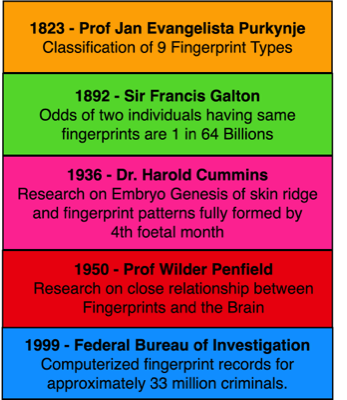The History of Dermatoglyphics
Thumbprints found on contracts over two thousand years ago show that the Chinese have long used fingerprints for signature and identification.
But for the Western World, fingerprints were 'discovered' by Sir Francis Galton, a cousin of Charles Darwin, in1892. Since then, massive research has proven a direct correlation between fingerprints and a person's medical and behavioral profile.
In 1823, Prof Jan Evangelista Purkynje, a professor of anatomy at the University of Breslau, published his thesis on the first system of classification of 9 Fingerprint types based on their geometric arrangements. He makes no mention of the value of fingerprints for personal identification and his work was not recognised internationally for many years.
In 1858 The English first began using fingerprints when Sir William Herschel, Chief Magistrate of the Hooghly district in Jungipoor, India, first used fingerprints on native contracts.
In 1880, Dr. Faulds published an article in the Scientific Journal, "Nautre" (nature). He discussed fingerprints as a means of personal identification and printers ink as a method for obtaining
such fingerprints. He was credited with the first fingerprint identification of a greasy fingerprint left on an alcohol bottle.
In 1882, Gilbert Thompson of the U.S. Geological Survey in New Mexico used his fingerprints on a document to prevent forgery. And the first known use of fingerprints in the United States
In 1892, Sir Francis Galton, a British anthropologist, published his book, "Fingerprints, " establishing the individuality and permanence of fingerprints. The book included the first classification system for fingerprints: Arch, Loop, and Whorl.
He was able to prove that fingerprints do not scientifically change throughout an individual's lifetime, and that no two fingerprints are the same.
According to his calculations, the odds of two individual fingerprints being the same were 1 in 64 billion.
1901 Introduction of fingerprints for criminal identification in England and Wales, using Galton's observations and revised by Sir Edward Richard Henry. Thus began the Henry Classification System, used even today in all English-speaking countries.
1902 First systematic use of fingerprints in the U.S. by the New York Civil Service Commission for testing. Dr. Henry P. DeForrest pioneers U.S. fingerprints.
1903 The New York State Prison system began the first systematic use of fingerprints in the U.S. for Criminals.
1924 An act of congress established the Identification Division of the F.B.I.. The National Bureau and Leavenworth consolidated to form the nucleus of the F.B.I. fingerprint files.
In 1926, Dr. Harold Cummins, M.D., is universally acknowledged as the Father of Dermatoglyphics. Harold studied all aspects of fingerprint analysis, from anthropology to genetics, from embryology to the study of malformed hands with from two to seven fingers. He pulled together the diverse work of his predecessors, added original research, and set the field's standards still in force to the present.
In 1936, Dr. Harold Cummins & Dr. Charles Midlo also researched the embryo-genesis of skin ridge patterns and established that the fingerprint patterns actually develop in the womb and are fully formed by the fourth fetal month.
In 1943, Dr. Harold Cummins published a book, "Finger Prints, Palms and Soles," a bible in the field of dermatoglyphics. In this book, he mentioned his research on embryo-genesis of skin ridge patterns in detail.
1946 The Federal Bureau of Investigation (F.B.I.) had processed 100 million fingerprint cards in manually maintained files, and by 1971, 200 million cards. With the introduction of AFIS technology, the files were split into computerized criminal files and manually maintained civil files.
1950 American-Canadian neurosurgeon Professor Winder Penfield published the chart between brain regions and bodily functions. The relationship between fingerprints and the brain has also clearly indicated.
In 1968, Sarah Holt, whose own work "The Genetics of Dermal Ridges", summarizes her research in dermatoglyphics patterns of both the fingers and the palm in various peoples, both normal and congenitally afflicted.
From 1970, a large number of professional papers related to dermatoglyphics were issued and have proven that dermatoglyphics cannot be replaced both physiology and psychology.
Dermatoglyphics, which is remarkable and changeless, is analyzed and proven with evidence in anthropology, genetics, and statistics.
In 1983, Dr. Howard Gardner developed a theory of Multiple Intelligence. Through this Multiple Intelligence, he tried answering not "how SMART an Individual is But rather how is he SMART?”
In 1985, Dr. Chen Yi Mou, Phd. of Harvard University research Dermatoglyphics based on Multiple Intelligence theory of Dr. Howard Gardner, is the first apply dermatoglyphics to educational fields and brain physiology.
From 1992 to 1994, the professional papers about dermatoglyphics focused on particular genetic medicine fields such as sudden infant death syndrome, endometriosis, Alzheimer's disease, auditory processing disorders, nasal cavities, etc tracheas, immunity diseases, Tuberculosis and down syndrome.
1999 The Federal Bureau of Investigation (F.B.I.) had planned to stop using paper fingerprint cards inside their new Integrated AFIS (IAFIS) site at Clarksburg, WV. IAFIS will initially have individual computerized fingerprint records for approximately 33 million criminals. Old paper fingerprint cards for the civil files are still manually maintained in a warehouse facility in Fairmont, WV.
2004 IBMBS- International Behavioural & Medical Biometrics Society
IBMBS is a Non-Governmental Organisation working on ket aspects of Biometric and Behavioural Sciences. IBMBS organizes International conferences on Biometrics since the 1990s. Over 7000 reports and thesis were published.
Nowadays U.S., Japan, China & Taiwan apply Dermatoglyphics to educational fields, expecting to improve teaching qualities and raising learning efficiency by knowing various learning styles.
To summarise, we can say that scientists discovered the relevance of fingerprints and the multiple intelligence of a human for nearly two centuries.
Fingerprints have been used for many years as accepted tools in criminology and for identification.
Numerous scientists and medical experts have studied Dermatoglyphics by observing, recording, comparing, assembling, and eventually organizing all the data to obtain an accurate analysis of an individual's hidden talents and strengths.

G-Code Consultancy
Decipher Your Genetic Code
